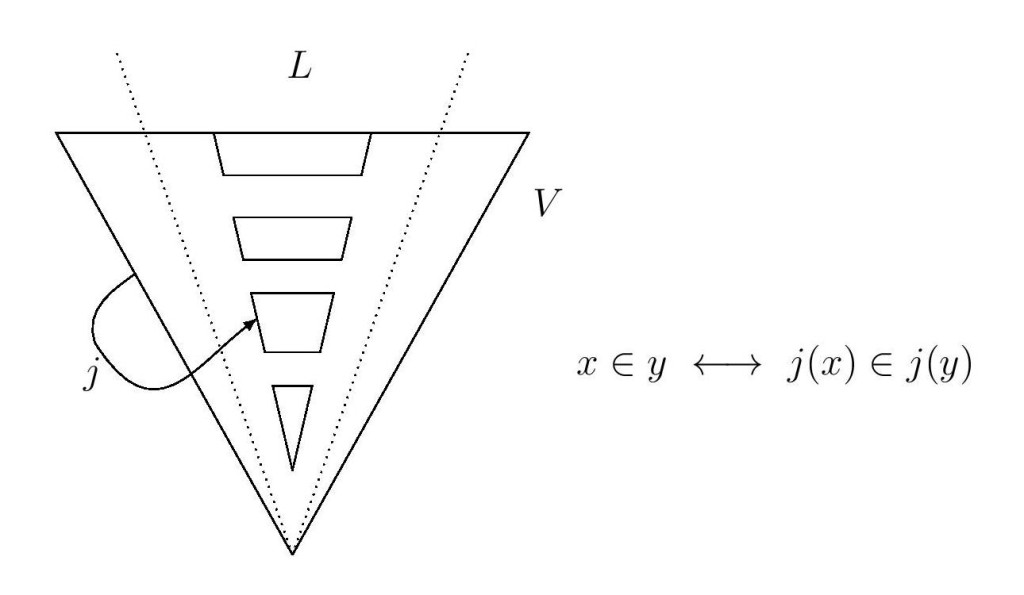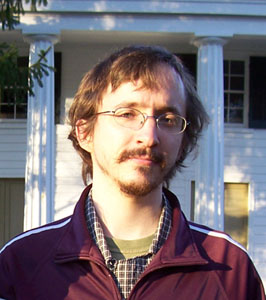 In set theory, we have the phenomenon of the universal definition. This is a property $\phi(x)$, first-order expressible in the language of set theory, that necessarily holds of exactly one set, but which can in principle define any particular desired set that you like, if one should simply interpret the definition in the right set-theoretic universe. So $\phi(x)$ could be defining the set of real numbes $x=\mathbb{R}$ or the integers $x=\mathbb{Z}$ or the number $x=e^\pi$ or a certain group or a certain topological space or whatever set you would want it to be. For any mathematical object $a$, there is a set-theoretic universe in which $a$ is the unique object $x$ for which $\phi(x)$.
In set theory, we have the phenomenon of the universal definition. This is a property $\phi(x)$, first-order expressible in the language of set theory, that necessarily holds of exactly one set, but which can in principle define any particular desired set that you like, if one should simply interpret the definition in the right set-theoretic universe. So $\phi(x)$ could be defining the set of real numbes $x=\mathbb{R}$ or the integers $x=\mathbb{Z}$ or the number $x=e^\pi$ or a certain group or a certain topological space or whatever set you would want it to be. For any mathematical object $a$, there is a set-theoretic universe in which $a$ is the unique object $x$ for which $\phi(x)$.
The universal definition can be viewed as a set-theoretic analogue of the universal algorithm, a topic on which I have written several recent posts:
- The universal algorithm
- A program that accepts exactly any desired finite set, in the right universe
- Every function can be computable!
Let’s warm up with the following easy instance.
Theorem. Any particular real number $r$ can become definable in a forcing extension of the universe.
Proof. By Easton’s theorem, we can control the generalized continuum hypothesis precisely on the regular cardinals, and if we start (by forcing if necessary) in a model of GCH, then there is a forcing extension where $2^{\aleph_n}=\aleph_{n+1}$ just in case the $n^{th}$ binary digit of $r$ is $1$. In the resulting forcing extension $V[G]$, therefore, the real $r$ is definable as: the real whose binary digits conform with the GCH pattern on the cardinals $\aleph_n$. QED
Since this definition can be settled in a rank-initial segment of the universe, namely, $V_{\omega+\omega}$, the complexity of the definition is $\Delta_2$. See my post on Local properties in set theory to see how I think about locally verifiable and locally decidable properties in set theory.
If we push the argument just a little, we can go beyond the reals.
Theorem. There is a formula $\psi(x)$, of complexity $\Sigma_2$, such that for any particular object $a$, there is a forcing extension of the universe in which $\psi$ defines $a$.
Proof. Fix any set $a$. By the axiom of choice, we may code $a$ with a set of ordinals $A\subset\kappa$ for some cardinal $\kappa$. (One well-orders the transitive closure of $\{a\}$ and thereby finds a bijection $\langle\mathop{tc}(\{a\}),\in\rangle\cong\langle\kappa,E\rangle$ for some $E\subset\kappa\times\kappa$, and then codes $E$ to a set $A$ by an ordinal pairing function. The set $A$ tells you $E$, which tells you $\mathop{tc}(\{a\})$ by the Mostowski collapse, and from this you find $a$.) By Easton’s theorem, there is a forcing extension $V[G]$ in which the GCH holds at all $\aleph_{\lambda+1}$ for a limit ordinal $\lambda<\kappa$, but fails at $\aleph_{\kappa+1}$, and such that $\alpha\in A$ just in case $2^{\aleph_{\alpha+2}}=\aleph_{\alpha+3}$ for $\alpha<\kappa$. That is, we manipulate the GCH pattern to exactly code both $\kappa$ and the elements of $A\subset\kappa$. Let $\phi(x)$ assert that $x$ is the set that is decoded by this process: look for the first stage where the GCH fails at $\aleph_{\lambda+2}$, and then extract the set $A$ of ordinals, and then check if $x$ is the set coded by $A$. The assertion $\phi(x)$ did not depend on $a$, and since it can be verified in any sufficiently large $V_\theta$, the assertion $\phi(x)$ has complexity $\Sigma_2$. QED
Let’s try to make a better universal definition. As I mentioned at the outset, I have been motivated to find a set-theoretic analogue of the universal algorithm, and in that computable context, we had a universal algorithm that could not only produce any desired finite set, when run in the right universe, but which furthermore had a robust interaction between models of arithmetic and their top-extensions: any set could be extended to any other set for which the algorithm enumerated it in a taller universe. Here, I’d like to achieve the same robustness of interaction with the universal definition, as one moves from one model of set theory to a taller model. We say that one model of set theory $N$ is a top-extension of another $M$, if all the new sets of $N$ have rank totally above the ranks occuring in $M$. Thus, $M$ is a rank-initial segment of $N$. If there is a least new ordinal $\beta$ in $N\setminus M$, then this is equivalent to saying that $M=V_\beta^N$.
Theorem. There is a formula $\phi(x)$, such that
- In any model of ZFC, there is a unique set $a$ satisfying $\phi(a)$.
- For any countable model $M\models\text{ZFC}$ and any $a\in M$, there is a top-extension $N$ of $M$ such that $N\models \phi(a)$.
Thus, $\phi(x)$ is the universal definition: it always defines some set, and that set can be any desired set, even when moving from a model $M$ to a top-extension $N$.
Proof. The previous manner of coding will not achieve property 2, since the GCH pattern coding started immediately, and so it would be preserved to any top extension. What we need to do is to place the coding much higher in the universe, so that in the top extension $N$, it will occur in the part of $N$ that is totally above $M$.
But consider the following process. In any model of set theory, let $\phi(x)$ assert that $x$ is the empty set unless the GCH holds at all sufficiently large cardinals, and indeed $\phi(x)$ is false unless there is a cardinal $\delta$ and ordinal $\gamma<\delta^+$ such that the GCH holds at all cardinals above $\aleph_{\delta+\gamma}$. In this case, let $\delta$ be the smallest such cardinal for which that is true, and let $\gamma$ be the smallest ordinal working with this $\delta$. So both $\delta$ and $\gamma$ are definable. Now, let $A\subset\gamma$ be the set of ordinals $\alpha$ for which the GCH holds at $\aleph_{\delta+\alpha+1}$, and let $\phi(x)$ assert that $x$ is the set coded by the set $A$.
It is clear that $\phi(x)$ defines a unique set, in any model of ZFC, and so (1) holds. For (2), suppose that $M$ is a countable model of ZFC and $a\in M$. It is a fact that every countable model of ZFC has a top-extension, by the definable ultrapower method. Let $N_0$ be a top extension of $M$. Let $N=N_0[G]$ be a forcing extension of $N_0$ in which the set $a$ is coded into the GCH pattern very high up, at cardinals totally above $M$, and such that the GCH holds above this coding, in such a way that the process described in the previous paragraph would define exactly the set $a$. So $\phi(a)$ holds in $N$, which is a top-extension of $M$ as no new sets of small rank are added by the forcing. So statement (2) also holds. QED
The complexity of the definition is $\Pi_3$, mainly because in order to know where to look for the coding, one needs to know the ordinals $\delta$ and $\gamma$, and so one needs to know that the GCH always holds above that level. This is a $\Pi_3$ property, since it cannot be verified locally only inside some $V_\theta$.
A stronger analogue with the universal algorithm — and this is a question that motivated my thinking about this topic — would be something like the following:
Question. Is there is a $\Sigma_2$ formula $\varphi(x)$, that is, a locally verifiable property, with the following properties?
- In any model of ZFC, the class $\{x\mid\varphi(x)\}$ is a set.
- It is consistent with ZFC that $\{x\mid\varphi(x)\}$ is empty.
- In any countable model $M\models\text{ZFC}$ in which $\{x\mid\varphi(x)\}=a$ and any set $b\in M$ with $a\subset b$, then there is a top-extension $N$ of $M$ in which $\{x\mid\varphi(x)\}=b$.
An affirmative answer would be a very strong analogue with the universal algorithm and Woodin’s theorem about which I wrote previously. The idea is that the $\Sigma_2$ properties $\varphi(x)$ in set theory are analogous to the computably enumerable properties in computability theory. Namely, to verify that an object has a certain computably enumerable property, we run a particular computable process and then sit back, waiting for the process to halt, until a stage of computation arrives at which the property is verified. Similarly, in set theory, to verify that a set has a particular $\Sigma_2$ property, we sit back watching the construction of the cumulative set-theoretic universe, until a stage $V_\beta$ arrives that provides verification of the property. This is why in statement (3) we insist that $a\subset b$, since the $\Sigma_2$ properties are always upward absolute to top-extensions; once an object is placed into $\{x\mid\varphi(x)\}$, then it will never be removed as one makes the universe taller.
So the hope was that we would be able to find such a universal $\Sigma_2$ definition, which would serve as a set-theoretic analogue of the universal algorithm used in Woodin’s theorem.
If one drops the first requirement, and allows $\{x\mid \varphi(x)\}$ to sometimes be a proper class, then one can achieve a positive answer as follows.
Theorem. There is a $\Sigma_2$ formula $\varphi(x)$ with the following properties.
- If the GCH holds, then $\{x\mid\varphi(x)\}$ is empty.
- For any countable model $M\models\text{ZFC}$ where $a=\{x\mid \varphi(x)\}$ and any $b\in M$ with $a\subset b$, there is a top extension $N$ of $M$ in which $N\models\{x\mid\varphi(x)\}=b$.
Proof. Let $\varphi(x)$ assert that the set $x$ is coded into the GCH pattern. We may assume that the coding mechanism of a set is marked off by certain kinds of failures of the GCH at odd-indexed alephs, with the pattern at intervening even-indexed regular cardinals forming the coding pattern. This is $\Sigma_2$, since any large enough $V_\theta$ will reveal whether a given set $x$ is coded in this way. And because of the manner of coding, if the GCH holds, then no set is coded. Also, if the GCH holds eventually, then only a set-sized collection is coded. Finally, any countable model $M$ where only a set is coded can be top-extended to another model $N$ in which any desired superset of that set is coded. QED
Update. Originally, I had proposed an argument for a negative answer to the question, and I was actually a bit disappointed by that, since I had hoped for a positive answer. However, it now seems to me that the argument I had written is wrong, and I am grateful to Ali Enayat for his remarks on this in the comments. I have now deleted the incorrect argument.
Meanwhile, here is a positive answer to the question in the case of models of $V\neq\newcommand\HOD{\text{HOD}}\HOD$.
Theorem. There is a $\Sigma_2$ formula $\varphi(x)$ with the following properties:
- In any model of $\newcommand\ZFC{\text{ZFC}}\ZFC+V\neq\HOD$, the class $\{x\mid\varphi(x)\}$ is a set.
- It is relatively consistent with $\ZFC$ that $\{x\mid\varphi(x)\}$ is empty; indeed, in any model of $\ZFC+\newcommand\GCH{\text{GCH}}\GCH$, the class $\{x\mid\varphi(x)\}$ is empty.
- If $M\models\ZFC$ thinks that $a=\{x\mid\varphi(x)\}$ is a set and $b\in M$ is a larger set $a\subset b$, then there is a top-extension $N$ of $M$ in which $\{x\mid \varphi(x)\}=b$.
Proof. Let $\varphi(x)$ hold, if there is some ordinal $\alpha$ such that every element of $V_\alpha$ is coded into the GCH pattern below some cardinal $\delta_\alpha$, with $\delta_\alpha$ as small as possible with that property, and $x$ is the next set coded into the GCH pattern above $\delta_\alpha$. This is a $\Sigma_2$ property, since it can be verified in any sufficiently large $V_\theta$.
In any model of $\ZFC+V\neq\HOD$, there must be some sets that are no coded into the $\GCH$ pattern, for if every set is coded that way then there would be a definable well-ordering of the universe and we would have $V=\HOD$. So in any model of $V\neq\HOD$, there is a bound on the ordinals $\alpha$ for which $\delta_\alpha$ exists, and therefore $\{x\mid\varphi(x)\}$ is a set. So statement (1) holds.
Statement (2) holds, because we may arrange it so that the GCH itself implies that no set is coded at all, and so $\varphi(x)$ would always fail.
For statement (3), suppose that $M\models\ZFC+\{x\mid\varphi(x)\}=a\subseteq b$ and $M$ is countable. In $M$, there must be some minimal rank $\alpha$ for which there is a set of rank $\alpha$ that is not coded into the GCH pattern. Let $N$ be an elementary top-extension of $M$, so $N$ agrees that $\alpha$ is that minimal rank. Now, by forcing over $N$, we can arrange to code all the sets of rank $\alpha$ into the GCH pattern above the height of the original model $M$, and we can furthermore arrange so as to code any given element of $b$ just above that coding. And so on, we can iterate it so as to arrange the coding above the height of $M$ so that exactly the elements of $b$ now satisfy $\varphi(x)$, but no more. In this way, we will ensure that $N\models\{x\mid\varphi(x)\}=b$, as desired. QED
I find the situation unusual, in that often results from the models-of-arithmetic context generalize to set theory with models of $V=\HOD$, because the global well-order means that models of $V=\HOD$ have definable Skolem functions, which is true in every model of arithmetic and which sometimes figures implicitly in constructions. But here, we have the result of Woodin’s theorem generalizing from models of arithmetic to models of $V\neq\HOD$. Perhaps this suggests that we should expect a fully positive solution for models of set theory.
Further update. Woodin and I have now established the fully general result of the universal finite set, which subsumes much of the preliminary early analysis that I had earlier made in this post. Please see my post, The universal finite set.


